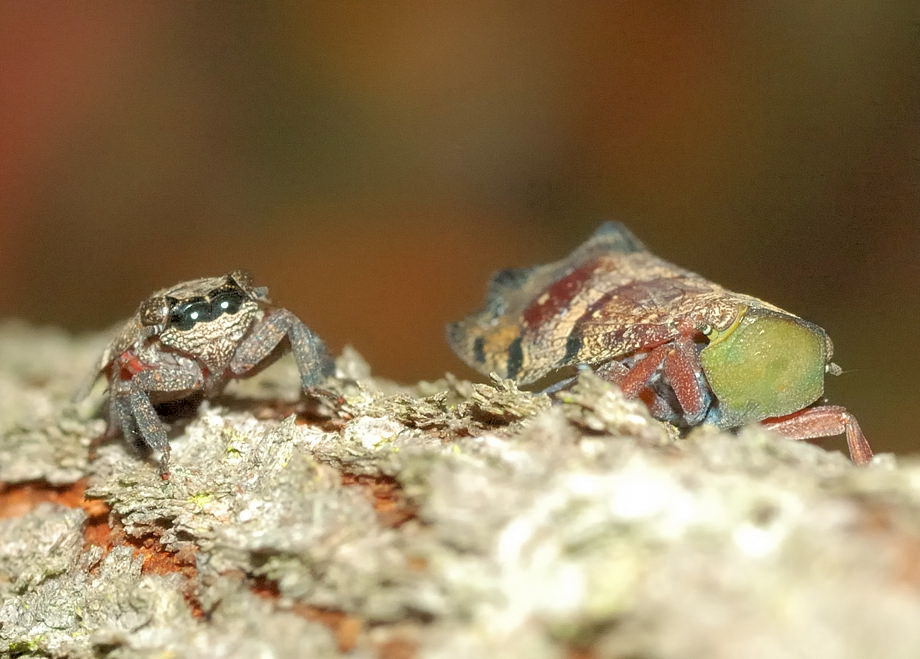|
| |
Order
Hemiptera
- This page contains pictures and information about Board-frons Planthoppers that we found in the Brisbane area,
Queensland, Australia.
-
 - Two Board-frons Planthoppers of different species
-
- Members in this family are medium in size with broad body. They have mottled
brown forewings and coloured abdomen, usually brown, red, yellow or orange in colour.
All of them have broad frons (front part of head).
-
- They can be found resting on the trunk or large stems of host plants, usually Eucalyptus or
Acacia. They are not noticeable because of their camouflaged
colours. When we come close to them, they will walk to other spots, either up,
down or sideway, and stop moving. If we come even closer and try to touch them, they will jump with a 'tick' sound and fly away.
-

  -
- Females lay eggs on tree trunks or leaves. The eggs are covered with a
white waxy secretion produced by the ovipositing female. Nymphs are
usually brown to dark brown in colour. Nymphs habit are about the same as the
adults. Like other members in the Hemiptera order,
Planthoppers have their sucking mouth-parts to feed on host plants by sucking
up the sap.
-
- We summarized the general information of Board-frons Planthoppers in this Biology page.
-
- The Australian Eurybrachyidae are quite
distinctive from the world fauna. Most of them are found only in Australia. All Australian species belong to the
subfamily Platybrachyinae, most in tribe Platybrachyini and a few in
tribe Dardini.
-
 Tribe Platybrachini
- Members in this tribe are medium in size with broad body. They have mottled
brown forewings and coloured abdomen, usually brown, red, yellow or orange in colour.
All of them have broad frons Tribe Platybrachini
- Members in this tribe are medium in size with broad body. They have mottled
brown forewings and coloured abdomen, usually brown, red, yellow or orange in colour.
All of them have broad frons
-
-
-
-
-
-
-
 Tribe Dardini
- Members in this tribe are small in size. They have mottled
brown forewings and coloured abdomen, usually brown, red, yellow or orange in colour.
All of them have broad frons Tribe Dardini
- Members in this tribe are small in size. They have mottled
brown forewings and coloured abdomen, usually brown, red, yellow or orange in colour.
All of them have broad frons
-
-
-
-
-
-
-
-
- Unknown Planthoppers - We put
those un-identified planthoppers species in this page. Please advise
if you know what species they are.
- Reference:
- 1. Insects
of Australia, CSIRO, Division of Entomology, Melbourne University
Press, 2nd Edition 1991, pp 479.
- 2. Family Eurybrachyidae
- Fletcher, M.J. and Larivière, M.-C. (2009 and updates).
- 3. Genus
Platybrachys Stål sensu lato - By Murray J. Fletcher, 08 April 2007.
- 4. Checklist for Platybrachyini Schmidt, 1908 - Australian Faunal Directory, Australian Biological Resources Study, 2008.
- 5. Northern
Territory Insects, A Comprehensive Guide CD - Graham Brown, 2009.
- Back to Top
[ Up ] [ Delphacidae ] [ Cixiidae ] [ Fulgoridae ] [ Achilidae ] [ Derbidae ] [ Issidae ] [ Flatidae ] [ Eurybrachyidae ] [ Ricaniidae ] [ Lophopidae ] [ Other Hoppers and Unidentified Hoppers ]
| |
|




 Tribe Platybrachini
- Members in this tribe are medium in size with broad body. They have mottled
brown forewings and coloured abdomen, usually brown, red, yellow or orange in colour.
All of them have broad frons
Tribe Platybrachini
- Members in this tribe are medium in size with broad body. They have mottled
brown forewings and coloured abdomen, usually brown, red, yellow or orange in colour.
All of them have broad frons  Tribe Dardini
- Members in this tribe are small in size. They have mottled
brown forewings and coloured abdomen, usually brown, red, yellow or orange in colour.
All of them have broad frons
Tribe Dardini
- Members in this tribe are small in size. They have mottled
brown forewings and coloured abdomen, usually brown, red, yellow or orange in colour.
All of them have broad frons 